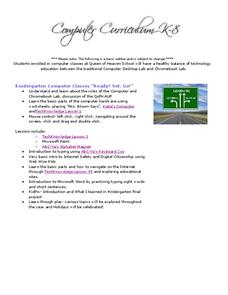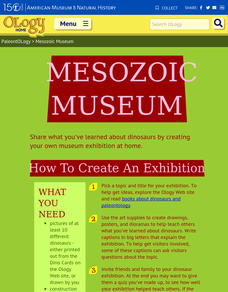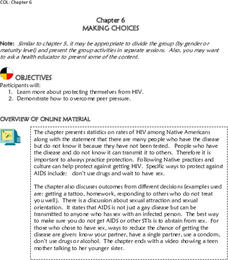EngageNY
Equivalent Rational Expressions
Rational expressions are just fancy fractions! Pupils apply fractions concepts to rational expressions. They find equivalent expressions by simplifying rational expressions using factoring. They include limits to the domain of the...
Star Date
Shadow Play
Three activities make up a solar system lesson that features the sun, its light, and the shadows it produces. Scholars step outside to discover the changes shadows make at different times of day, take part in a demonstration of...
EngageNY
Comparison of Numbers Written in Scientific Notation and Interpreting Scientific Notation Using Technology
Examine numbers in scientific notation as a comparison of size. The 14th lesson in the series asks learners to rewrite numbers as the same power of 10 in scientific notation to make comparisons. Pupils also learn how to use a calculator...
Google
Online Safety Roadshow Activity
What does it mean to have digital citizenship? A set of lessons teach middle schoolers how to be safe and productive online. From sharing posts to creating secure passwords, learners discuss the importance of remaining diligent—and...
Next Generation Science Storylines
Why Don't Antibiotics Work Like They Used To?
Bacteria get more resistant to antibiotics every year. Learn the reason for this pattern and how scientists are addressing the problem in a six-week unit. Learners analyze different types of bacteria and their adaptations.
Queen of Heaven School
Computer Curriculum
Need some extra resources to get your class computer savvy? How about several years' worth? Show pupils in K-8 a progression of proficiency in a series of computer lessons. Learners master the basics, then work with the Microsoft Office...
Kenan Fellows
Introduction to a Flight Computer
Keep your hands on the wheel—at all times! Scholars learn why pilots use a flight computer through a high-flying demonstration. Making calculations for speed, distance, or time is automatic if you know how to use a flight computer.
American Museum of Natural History
Mesozoic Museum
Mini museum curators create an exhibit that showcases the Mesozoic era. Pupils use their knowledge of dinosaurs to make informative posters, drawings, and dioramas. Following three steps to complete the hands-on activity, scholars read...
ABCya
Word BINGO
Practicing sight words is all fun and games with this app! Users hear, read, and spell words off the Dolch Word List. But that's not all! Players also get to create their own avatar, collect BINGO bugs, view their scores, and more within...
Star Date
Build Your Own Galaxy
Don't just look at pictures of the Milky Way galaxy, build it with this hands-on activity in which scientists recreate the galaxy we live in.
Chicago Botanic Garden
Personal Choices and the Planet
How big is your footprint? Activity three culminates the series by having groups complete carbon footprint audits with people in their schools and/or around the districts. Groups then gather their data, create a presentation including...
LABScI
DNA Structure: Gumdrop Modeling
DNA molecules hold the secrets that make us unique. The fourth of 12 lessons explores the structure of DNA by building candy models. After building the models, young scientists break their models to begin the process of DNA replication....
K5 Learning
Emma's Favorite Restaurant
Scholars answer six short answer questions following a tale about a family who decides to try a new restaurant and the surprise their children feel when they enjoy their meal.
NOAA
Oceans of Energy
Are the earth's oceans really just giant batteries, waiting for their energy to be harnessed? Middle school mechanical engineers will be shocked by the amazing amount of energy that forms around them after diving into part four of a...
Trinity University
Julius Caesar: The Power of Persuasion
"Friend, Romans, countrymen, lend me your ears..." Those words begin one of the most persuasive speeches in literature. Explore the elements of persuasion in a series of lessons related to William Shakespeare's Julius...
New York State Education Department
Comprehensive English Examination: June 2013
Tired of having to create your own formative assessments? Use a ready-made resource to assess listening and reading comprehension, essay writing, and literary skills. Scholars work through 28 questions in response to five different texts.
Healthy Native Youth
Chapter 6: Making Choices
A lesson looks closely at risky behavior such as teen pregnancy and sexually transmitted diseases. Middle schoolers use a question box to ask questions anonymously. They role-play what life would be like if they became pregnant then...
Curated OER
Antifreeze - Anti Fish
Students participate in the production of a play that highlights the direct linkage between storm drains and natural river, stream, or creek ecosystems. They explore their thoughts, feelings, and actions through dramatic interaction and...
Curated OER
Name That Sound
First graders match different pictures to the correct beginning and ending sounds they go with. In this sound lesson plan, 1st graders will use the computer program Kid Pix to go through a variety of pictures. They then match the picture...
Curated OER
Technology: Koo Koo for Clocks
Third graders design and make clocks compiling a materials list, creating adesign portfolio, and recording progress in a daily log. After making a full-size drawing of their clocks and with the assistance of high school technology...
Curated OER
Open Wide
Students practice letter(s) map(s) along with phoneme sequences and sounds that make the /o/ sound in both spoken and written formats. They also decode words containing /o/ sounds to work towards becoming more fluent readers beginning...
Curated OER
The Princess and the Pea
Students participate in various shared reading and writing activities related to the classic fairytale "The Princess and the Pea." They identify the story elements, write an opening sentence for the beginning of the story, and discuss...
Curated OER
Pitch
Students experience sounds with different pitches. In this pitch lesson, students use open pipes as they are introduced to pitch, then make Straw Pan Pipes.
Curated OER
Time to Have Fun: Telling Time Activity
In this time learning exercise, students draw lines to match a set of events at a family carnival and their beginning and total activity times to an ending time given in a separate column. Answers included on page 2.
Other popular searches
- Open Ended Questions
- Open Ended Math Problems
- Writing Open Ended Questions
- Math Open Ended Questions
- Open Ended Response
- Reading Open Ended Questions
- Science Open Ended Questions
- Open Ended Questions
- Egypt Open Ended Questions
- Open Ended Fraction Problems
- Open Ended Problems
- Open Ended Plot Structure























